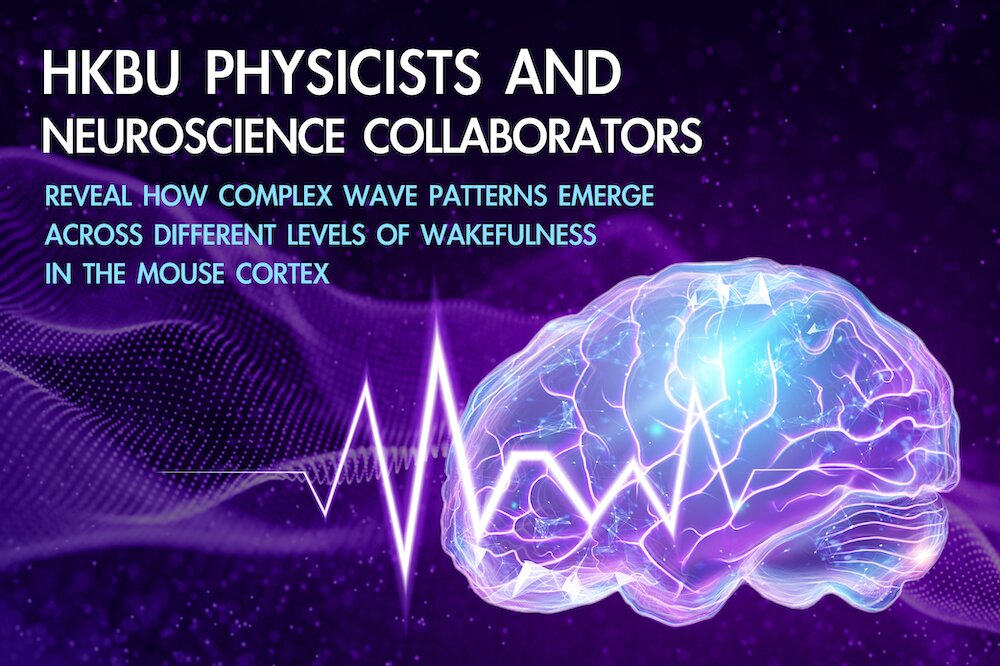HKBU physicists and neuroscience collaborators reveal how complex wave patterns emerge across different levels of wakefulness in the mouse cortex
17 Mar 2023

In the living brain, electrical activity is always present, also in the absence of external stimuli. In early studies aimed at understanding how perception and behavior emerges from neuronal activities, spontaneous (“ongoing”) activity was treated like “irrelevant noise” and removed by averaging over repeated trials. However, the first pioneering electroencephalography studies already recognized the significance of spontaneous neuronal activities and its relation to brain states, such as the during unconscious and conscious states of the brain. More recently, accumulating evidence showed that spontaneous cortical activity as well as evoked activity exhibit rich spatiotemporal patterns organized as traveling waves. How are the complex propagating neural dynamics unfolding both in space and in time associated with the processing of neuronal information and the brain internal state changes?
A recent interdisciplinary research collaboration between Professor Changsong Zhou’s group from the Department of Physics of Hong Kong Baptist University, Professor Pulin Gong from the School of Physics of the University of Sydney, and Professor Thomas Knöpfel’s Laboratory for Neuronal Circuit Dynamics at Imperial College London and HKBU sought to address these questions. The team revealed that the essential features of brain dynamics in space and in time differ in characteristics at different states of the brain. The work highlights neuronal signatures underlying the absence or presence of conscious wakefulness. The work, entitled "Complexity of cortical wave patterns of the wake mouse cortex", was recently published in a prestigious open access interdiscipline journal Nature Communications. Physics PhD graduate Dr. Yuqi Liang, Dr. Mianxin Liu, and postdoctoral fellow Dr. Junhao Liang of HKBU and Dr. Chenchen Song of Imperial College London are co-first authors for this work.
For this work, the team used mesoscopic voltage imaging approach to monitor electrical activity from the excitatory neurons of the upper layers of brain tissue known as the cortex, with high spatial coverage across both hemispheres which currently has only been achieved in mice. The team imaged the brain activity of these mice as they transitioned from anesthetized to woken states, as well as in anesthetic-free fully awake animals. Then, the team used advanced phase velocity fields (PVF) wave analysis method adapted from turbulence physics on these mesoscopic voltage imaging data. The team found that, when recovering from anesthesia to wakefulness, the directions of these brain waves become less homogenous, and the speed of these waves changed. They also identified typical wave patterns, and the proportion of the different patterns changed with different brain states. To explain these observations, the team further developed a computational model of the key features and demonstrated that the model can reproduce the increased complexity of wave patterns that accompany approaching wakefulness as found in the experimental data. Using dynamical stability analysis, they found that the strong competition between global and local activity states underlies the emergence of spatiotemporal complexity during the transition from anesthesia to wakefulness. They then used the model to predict that long-range connections more efficiently transfer neural activities and information between cortical areas in the wakeful state.
This interdisciplinary collaborative research combines real-time optical voltage imaging experiments and computational analysis and modelling based on dynamical system theory to provide a set of brain activity signatures for the transition from anesthetized to wakeful states based on travelling waves in mice - including the increased spatiotemporal complexities of localized wave patterns - and outlined the possible underlying mechanism of these neural signatures. These signatures have far more complex spatiotemporal dynamics than expected by conventional views of temporal correlations or attractors, and may have implications for understanding conscious processes of brain functions.
Reference:
https://www.nature.com/articles/s41467-023-37088-6
Source:

